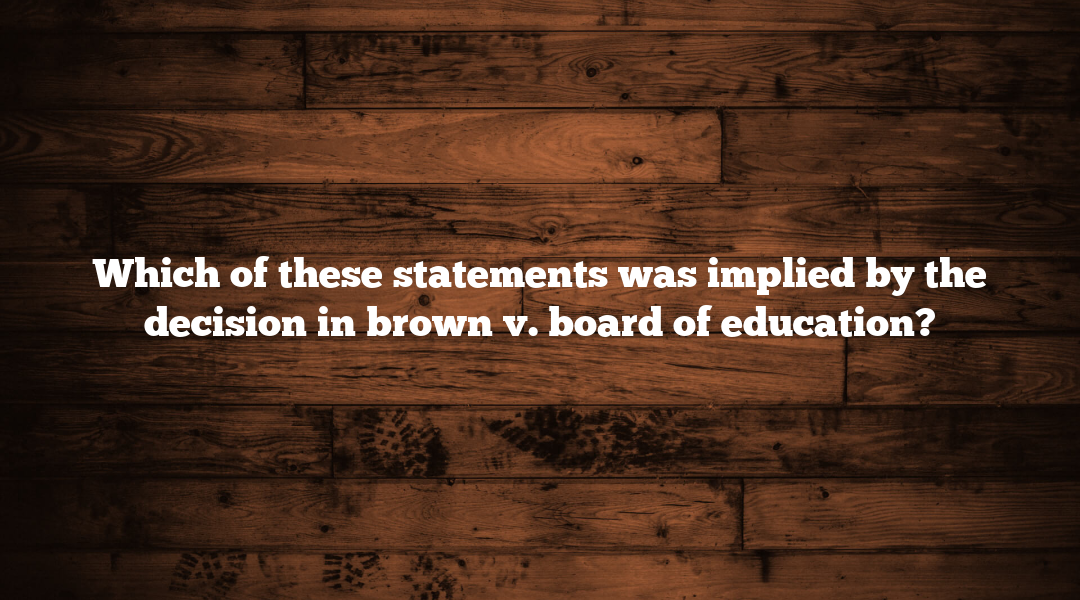Which of these statements was implied by the decision in brown v. board of education?
The Brown v. Board of Education decision stands as a pivotal moment in American legal history, dismantling the legal framework of racial segregation in schools. While the explicit legal outcomes are well-documented, this exploration delves into the silent significance of the case—the implied messages that reverberate beyond the courtroom, shaping the landscape of education and civil rights.
The Legal Landscape: Brown v. Board of Education
In 1954, the Supreme Court unanimously declared state laws establishing separate public schools for black and white students unconstitutional. Beyond the surface-level implications, the silent significance of the Brown v. Board of Education decision reveals a deeper layer of meaning.
Implied Message 1: Equality Transcending the Verdict
Implicit in the decision is a message about equality that transcends the explicit verdict. The Court, by striking down the notion of “separate but equal,” implicitly conveyed that equality is not merely a legal formality but a principle that should permeate every facet of the educational system.
Implied Message 2: Rethinking Societal Norms
The decision carried the silent significance of challenging societal norms. By dismantling segregated schooling, Brown v. Board of Education silently suggested a reevaluation of deeply ingrained norms that perpetuated racial segregation. It called for a societal shift in perceptions and expectations.
The Ripple Effect: Beyond Desegregation
Implied Message 3: Social Integration as a Silent Goal
The case had a ripple effect that extended beyond the immediate desegregation of schools. Implicit in the decision was a silent goal of promoting social integration. By fostering interactions among students of different races, Brown v. Board of Education aimed to build bridges and break down the barriers of prejudice and misunderstanding.
Implied Message 4: Cultural Transformation as a Subtext
The silent significance of Brown is found in its implicit message of cultural transformation. By dismantling the racially discriminatory education system, the decision silently called for a cultural shift—a transformation in societal attitudes towards diversity and inclusivity.
Challenges and Progress: Post-Brown Era
Implied Message 5: Implicit Bias Lurking in the Shadows
Despite the legal victory, the silent significance of Brown v. Board of Education acknowledged the presence of implicit bias lurking in the shadows. The decision silently recognized that biases, though not explicitly stated, could persist and undermine the pursuit of genuine equality.
Implied Message 6: The Unfinished Journey of Educational Equity
The decision implied an ongoing journey towards educational equity. While Brown marked a crucial step, it silently acknowledged that achieving true equity in education required continuous efforts to address systemic disparities and ensure that every student had equal opportunities.
Looking Ahead: Contemporary Implications
Implied Message 7: The Silent Legacy in Modern Debates
In the contemporary context, the silent significance of Brown v. Board of Education continues to echo in modern debates on education and civil rights. The decision’s silent legacy implies an ongoing responsibility to confront implicit biases, dismantle systemic barriers, and foster an inclusive educational environment.
Conclusion
In unraveling the silent significance of Brown v. Board of Education, we discover a tapestry of implied messages that go beyond the explicit legal rulings. The decision carries a silent significance that speaks to the very soul of societal transformation, equality, and justice. As we reflect on the case, it becomes evident that its impact is not confined to a specific era but reverberates through time, urging us to address implicit biases, challenge societal norms, and foster an educational landscape where every student is afforded equal opportunities. The silent significance of Brown v. Board is a call to embrace the unspoken messages and continue the journey towards a more just, equitable, and inclusive society.






